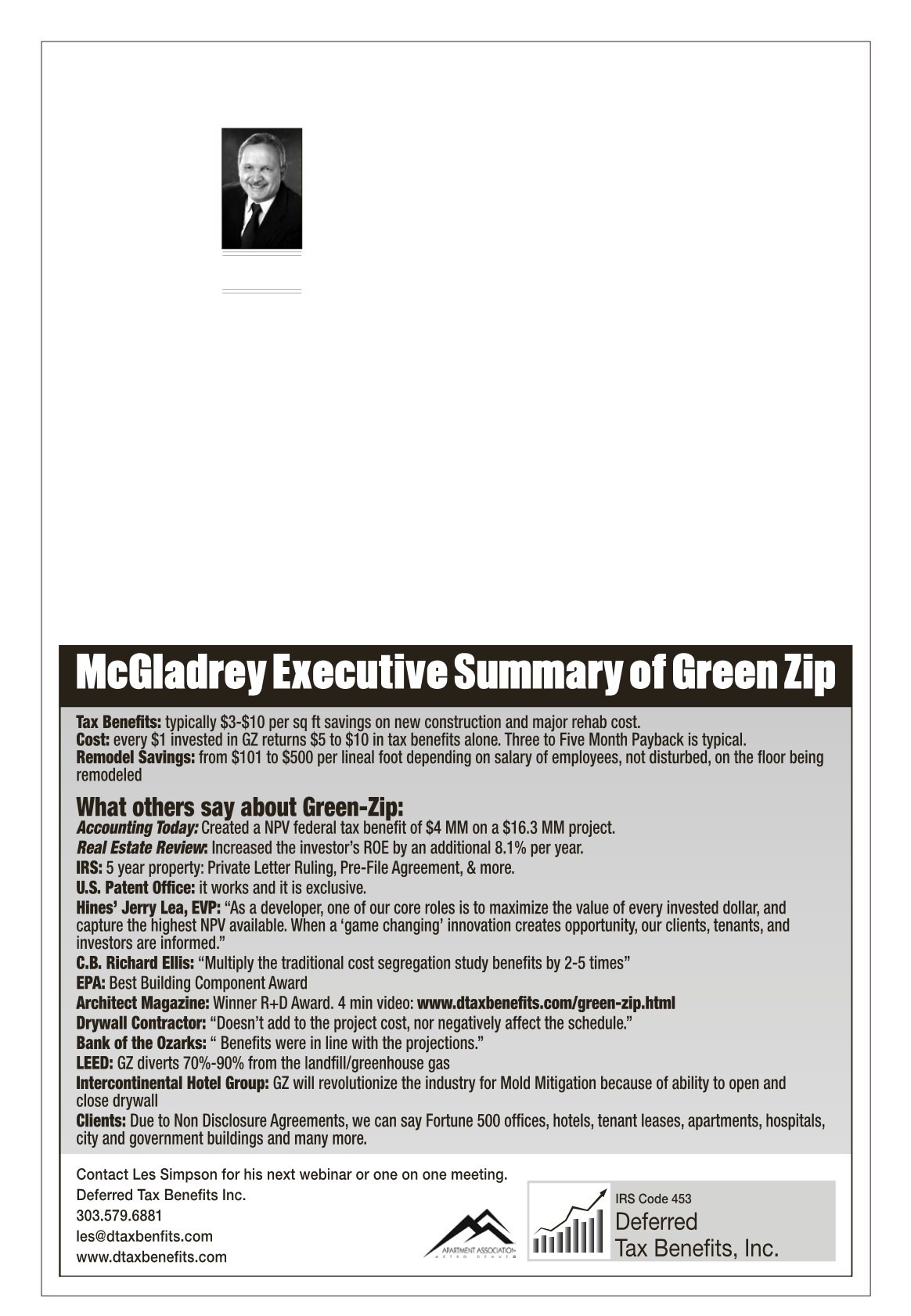

Page 18AA —
COLORADO REAL ESTATE JOURNAL
— February 18-March 3, 2015
C
ities are in competi-
tion to bring the
best companies to
the area that will provide
the most spendable dol-
lars to their communities.
Presently, they are able to
offer city tax benefits as well
as work with the state on
different waivers that offer
more incentives to move to
the area.
The more employees
and the bigger the profit
the company have mean
improving the economy
for the entire area, includ-
ing improvement for local,
second-line businesses that
are in the supply chain. This
benefits everyone in the
area, including more revenue
for schools and public ser-
vices we all use every day.
Are you starting to see why
it is so important for cities
to be able to offer large com-
panies incentives to come to
the area?
Cities that adopt new com-
mercial building standards
are able to offer federal tax
benefits to desired prospects
in addition to those noted
above. This is because of new
technology that allows com-
mercial real estate to be 70%
to 90% reconfigurable and
reusable.
What does this actually
mean? Reconfigurable and
reusable?
We hear
all the
time about
recycle
but reus-
able? This
change
ben-
efits almost
every area
of com-
mercial
real estate;
from the
architect who designs the
building to the contractor
who builds it. And in addi-
tion, cites themselves will
benefit by not having land-
fills continue to fill with haz-
ardous and toxic waste.
With this new technology,
the parts of the building
that are now reconfigurable
and reusable are most of
the interior. The interior I
am referring to consists of
the interior doors you walk
through, the windows you
peer into to see if someone
is behind the desk, the elec-
trical and plumbing that
connects the computers and
sinks, and all the drywall
and frames that that connect
everything (and that hide all
of this from public view).
These are the construction
materials that are demol-
ished and replaced with new
materials approximately
every five years in medi-
cal and commercial office
buildings, malls and other
commercial real estate.
According to the National
Association of Home
Builders, 26% of construc-
tion landfill by weight is dry-
wall. Drywall in landfills pro-
duce hydrogen sulfide gas,
which pollutes water tables
and is listed as hazardous
and toxic waste by the EPA.
Businessweek informed us
that 1% of all energy in U.S.
industry makes drywall
and equivalent amount of
emissions. In other words,
demolition of these spaces
every five years is one of our
biggest polluters to the envi-
ronment.
The one area of construc-
tion that changes all of these
areas to reusable is remov-
able, or demountable, dry-
wall joint tape. Until the dry-
wall tape goes on, everything
can be disassembled, reused
and relocated. The drywall
tape, once finished (mud and
paint), makes the interior of
the wall inaccessible to any-
thing except by demolition.
An award-winning, former
top Gensler architect and
Construction Technology
Professor at Texas A&M
has pioneered Green-Zip
demountable drywall tape
that “is the game changer
for commercial real estate,”
according to the EVP of
Hines, a premier developer.
In addition to the benefits
of the awards and approval
by the EPA and AIA, in
2008 the highest federal tax
courts approved tax ben-
efits of this new technology,
transforming everything
associated with all nonload-
bearing walls (drywall, studs,
headrails, interior doors
and windows, utilities, etc.)
to personal property under
the IRS Witco rules. This
tax category change from
the IRS allows companies
investing in buildings to add
an additional 8.1% Return
on Equity, according to Real
Estate Review. That is, 8.1%
in addition to the regular
return. Or, according to
McGladrey and EKS&H, the
tax benefits are equivalent to
saving $3 to $10 per square
foot in construction cost for
a profitable corporate offices.
Many Fortune 500 compa-
nies have taken advantage
of both the reusable benefits
and tax benefits, along with
hospitals, hotels, banks,
apartments and govern-
ment entities, which are
now building reconfigurable
buildings and enjoying the
tax benefits.
In addition to the tax bene-
fits, this new technology will
make their buildings 70% to
90% reusable, according to a
LEED Case Study. Every five
years, when they reconfigure
their space using the same
materials, they will save
$110 per lineal foot ($1,100
every 10 feet) in 2013 dol-
lars, according to a Turner
Construction Case Study.
The reuse benefits go up
every year with the increase
in construction materials.
A city, using the new
building standard, can now
attract major companies and
their millennial employees
to the area with federal tax
benefits and protect their
environment at the same
time. Another goal of our
officials in economic devel-
opment is meeting the con-
cerns of the millennials, our
future workforce. Cities are
being designed differently to
accommodate their concerns
for the environment as well
as their lifestyle. This is
a change that is good for
everyone. Providing more
spreadable income to the
city residents by provid-
ing federal tax benefits to
attractive companies while
protecting the environment
with reusable buildings.
Les Simpson
Deferred Tax
Benefits Inc.
Colorado’s First 70% Reconfigurable Building Benefits Architects, Owners and Contractors















